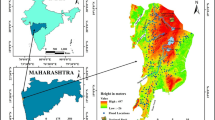Abstract
Every year, Taiwan endures typhoons and earthquakes; these natural hazards often induce landslides and debris flows. Therefore, watershed management strategies must consider the environmental vulnerabilities of local basins. Because many factors affect basin ecosystems, this study applied multiple criteria analysis and the analytical hierarchy process (AHP) to evaluate seven criteria in three phases (geographic phase, hydrologic phase, and societal phase). This study focused on five major basins in Taiwan: the Tan-Shui River Basin, the Ta-Chia River Basin, the Cho-Shui River Basin, the Tseng-Wen River Basin, and the Kao-Ping River Basin. The objectives were a comprehensive examination of the environmental characteristics of these basins and a comprehensive assessment of their environmental vulnerabilities. The results of a survey and AHP analysis showed that landslide area is the most important factor for basin environmental vulnerability. Of all these basins, the Cho-Shui River Basin in central Taiwan has the greatest environmental vulnerability.



Similar content being viewed by others
References
Briguglio, L. (1995). Small islands states and their economic vulnerabilities. World Development, 23, 1615–1632.
Chang, C. L., & Lo, S. L. (2005). Corresponding watershed management strategies for each subbasin with different land-use. The landuse management and development conference. Tainan, Taiwan, R.O.C. (In Chinese)
Chang, C. L., Chiueh, P. T., & Liou, Y. T. (2008a). Applying VIKOR to determine the land-use restraint strategies in a watershed. Environmental Engineering Science, 25(9), 1317–1324.
Chang, C. L., Chiueh, P. T., & Peng, Y. S. (2008b). A vulnerability analysis in the Fei-tsui reservoir watershed in Taiwan. Environmental Monitoring & Assessment, 143(1–3), 9–14.
Committee to Assess the Scientific Basis of the TMDL Approach to Water Pollution (2001). Assessing TMDL approach to water quality management. Washington, DC: National Academy Press.
Craig, E. H., & Karen, A. K. (1995), To normalize or not to normalize? Fat is the question. Environmental Toxicology and Chemistry, 14(5), 801–807.
Downs, P. W., Gregory, K. J., & Brookes, A. (1991). How integrated is river basin management? Environmental Management, 15(3), 299–309.
Gomontean, B., Gajaseni, J, Edwards-Jones, G., & Gajaseni, N. (2008). The development of appropriate ecological criteria and indicators for community forest conservation using participatory methods: A case study in northeastern Thailand. Ecological Indicators, 8, 614–624.
Jaspers, F. G. W. (2003). Institutional arrangements for integrated river basin management. Water Policy, 5, 77–90.
Kaly, U., & Pratt, C. (2000). Environmental Vulnerability Index: Development and provisional indices and profiles for Fiji, Samoa, Tuvalu and Vanuatu. SOPAC Technical Report, 306.
Kaly, U., Briguglio, L., McLeod, H., Schmall, S., Pratt, C., & Pal, R. (1999). Environmental vulnerability index (EVI) to summarise national environmental vulnerability profiles. SOPAC Technical Report, 275.
Kaly, U., Pratt, C., & Howorth, R. (2002). A framework for managing environmental vulnerability in Small Island Developing States. Development Bulletin, 58, 33–38.
Lin, J. S., Yu, S. L., & Lee, T. C. (2000). Managing Taiwan’s reservoir watersheds by zoning approach. Journal of the American Water Resources Association, 36(5), 989–1001.
Lu, S. Y., Cheng, J. D., & Brooks, K. N. (2001). Managing forests for watershed protection in Taiwan. Forest Ecology and Management, 143, 77–85.
Mendoza, G. A., & Prabhu, R. (2000). Development of a methodology for selecting criteria and indicators of sustainable forest management: a case study on participatory assessment. Envrionemntal Management, 26(6), 659–673.
Mostaghimi, S, Park, S. W., Cooke, R. A., & Wang, S. Y. (1997). Assessment of management alternatives on a small agriculture watershed. Water Research, 31(8), 1867–1878.
Noble, E. E., & Sanchez, P. P. (1993). A note on the information content of a consistent pairwise comparison judgment matrix of an AHP decision maker. Theory and Decision, 34(2), 99–108.
Opricovic, S., & Tzeng, G. H. (2004). Compromise solution by MCDM methods: A comparative analysis of VIKOR and TOPSIS. European Journal of Operational Resaerch, 156, 445–455.
Pantin, D. (1997). Alternative ecological vulnerability indicators for developing countries with special reference to small island developing states (SIDS). Report to UN Department of Economic and Social Affairs, 22.
Saaty, T. L. (1980). The analytic hierarchy process. New York: McGraw-Hill.
Saaty, T. L. (1990). How to make a decision: the Analytic Hierarchy Process. European Journal of Operational Research, 48(1), 9–26.
Saaty, T. L. (2008). Decision making with the analytic hierarchy process. International Journal of Services Sciences, 1(1), 83–98.
Tzeng, G. H., Lin, C. W., & Opricovic, S. (2005). Multi-criteria analysis of alternative-fuel buses for public transportation. Energy Policy, 33, 1373–1383.
U.S. Environmental Protection Agency (1991). Guidance for water quality-based decisions: The TMDL process. Assessment and Watershed Protection Division, U.S. EPA, Washington, DC.
Villa, F., & McLeod, H. (2002). Environmental vulnerability indicators for environmental planning and decision-making: guidelines and applications. Environmental Management, 29(3), 335–348.
Wang, X. (2001). Integrating water-quality management and land-use planning in a watershed context. Journal of Environmental Management, 61, 25–36.
Author information
Authors and Affiliations
Corresponding author
Rights and permissions
About this article
Cite this article
Chang, CL., Chao, YC. Using the analytical hierarchy process to assess the environmental vulnerabilities of basins in Taiwan. Environ Monit Assess 184, 2939–2945 (2012). https://doi.org/10.1007/s10661-011-2162-z
Received:
Accepted:
Published:
Issue Date:
DOI: https://doi.org/10.1007/s10661-011-2162-z




